|
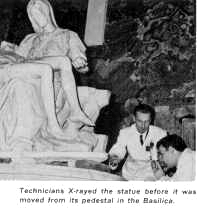 The story of the
Pieta's coming to America began in the fall of 1962, when His
Eminence Francis Cardinal Spellman asked Pope John XXIII to permit
Michelangelo's magnificent sculpture to be placed on exhibit
in the proposed Vatican Pavilion at the New York World's Fair.
Good Pope John agreed to the request and added that he would
also loan, for the same purpose, as a gesture of appreciation
for all America had done for the rest of the world, the ancient
statue of Christ, the Good Shepherd. Pope Paul VI confirmed the
actions of his predecessor and on the night of April 2, 1964, The story of the
Pieta's coming to America began in the fall of 1962, when His
Eminence Francis Cardinal Spellman asked Pope John XXIII to permit
Michelangelo's magnificent sculpture to be placed on exhibit
in the proposed Vatican Pavilion at the New York World's Fair.
Good Pope John agreed to the request and added that he would
also loan, for the same purpose, as a gesture of appreciation
for all America had done for the rest of the world, the ancient
statue of Christ, the Good Shepherd. Pope Paul VI confirmed the
actions of his predecessor and on the night of April 2, 1964,
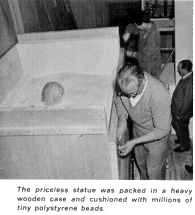 carefully
packed to withstand the rigors of a long land and sea voyage,
the Pieta left the Basilica of St. Peter in Vatican City for
the first time since Michelangelo placed it there. carefully
packed to withstand the rigors of a long land and sea voyage,
the Pieta left the Basilica of St. Peter in Vatican City for
the first time since Michelangelo placed it there.
Cushioned within a sturdy
wooden case by the most modern materials science has devised
and further secured inside a waterproof metal container, the
Pieta spent its first night outside the Basilica in a courtyard
of Vatican City.
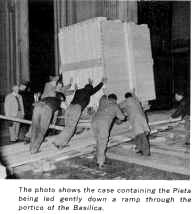 Early on Sunday
morning, April 5th, at the request of those to whom the safety
of the statues had been entrusted, the TN CRISTFORO COLOMBO,
flag ship of the Italian Line, moved slowly -- not into its regular
passenger pier berth -- but into the Floating Dry-dock in the
port of Naples served by the only derrick able to place the statues
in the location aboard ship selected to provide the greatest
possible protection for them. Early on Sunday
morning, April 5th, at the request of those to whom the safety
of the statues had been entrusted, the TN CRISTFORO COLOMBO,
flag ship of the Italian Line, moved slowly -- not into its regular
passenger pier berth -- but into the Floating Dry-dock in the
port of Naples served by the only derrick able to place the statues
in the location aboard ship selected to provide the greatest
possible protection for them.
Within an hour both the
Pieta and the Good Shepherd were aboard the COLOMBO and, after
returning to its regular berth and taking on its passengers,
the pride of the Italian Line sailed for New York with its precious
cargo.
The plans formulated for
the transport of the two Vatican treasures were as detailed and
complete as months of careful preparation and study could make
them. The Good Shepherd, packed in two concentric wooden cases
each containing its own layer of cushioning material and wrapped
in an asbestos blanket to protect it from fire, was placed in
a separate compartment in the hold of the ship. The lashings
and condition of the statue were inspected daily by a ship's
officer and a member of the Pieta Transport Committee.
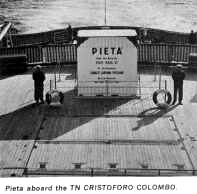 The Pieta, its
exterior case painted white with shipping marks of blue and topped
in brilliant international orange, the color most discernible
at sea, traveled lashed to steel deck shoes placed in position
a few days earlier while the COLOMBO was in Genoa. Steel guy
wires equipped with hydrostatic releases able to fee the entire
package from its confining cables, should it sink below the surface
of the sea, held the Pieta case to its deck fittings. As an added
safety measure, a signaling light buoy ready to go into operation
at a moment's notice was placed nearby so that if the necessity
arose it would signal over the international radio distress frequency
the location of the Pieta and would power a flashing beacon visible
fifteen miles at sea level and fifty miles at air search height.
Throughout the voyage two seamen guarded the precious cargo.
(The Pieta was insured for six million dollars; the Good Shepherd
for two million dollars.) The Pieta, its
exterior case painted white with shipping marks of blue and topped
in brilliant international orange, the color most discernible
at sea, traveled lashed to steel deck shoes placed in position
a few days earlier while the COLOMBO was in Genoa. Steel guy
wires equipped with hydrostatic releases able to fee the entire
package from its confining cables, should it sink below the surface
of the sea, held the Pieta case to its deck fittings. As an added
safety measure, a signaling light buoy ready to go into operation
at a moment's notice was placed nearby so that if the necessity
arose it would signal over the international radio distress frequency
the location of the Pieta and would power a flashing beacon visible
fifteen miles at sea level and fifty miles at air search height.
Throughout the voyage two seamen guarded the precious cargo.
(The Pieta was insured for six million dollars; the Good Shepherd
for two million dollars.)
Eight days later, the port
of New York welcomed the COLOMBO and its distinguished cargo
as tug boat horns blared and banners streamed in the early morning
breeze.
Moments after the COLOMBO
eased into its berth at its Hudson River pier, the Pieta and
the Good Shepherd were removed from the ship by the waiting derrick-barge
"Challenger." 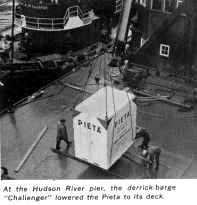 To avoid the heavy
Monday morning East River traffic and the danger of bringing
the statues through Hell Gate at the river's race rather than
at slack tide, it was decided to hold the statues on the derrick-barge
at the pier overnight. To avoid the heavy
Monday morning East River traffic and the danger of bringing
the statues through Hell Gate at the river's race rather than
at slack tide, it was decided to hold the statues on the derrick-barge
at the pier overnight.
The following morning,
April 14th, the statues began their second voyage as two solicitous
tugs carefully guided the barge down the Hudson River around
Manhattan Island, and up the East River to Flushing Bay.
Arriving at Whitestone
Parkway Bridge over Flushing Inlet in the same kind of heavy
downpour that had plagued their lorry trip from Rome to Naples,
the statues were promptly hoisted to trucks already in position
on the bridge forty feet overhead. A few minutes later, their
long 4,500 mile journey ended as the truck carrying them rolled
to a stop alongside the Vatican Pavilion in the World's Fair
grounds.
On Thursday, April 16th
the Pieta and the Good Shepherd were placed on their respective
pedestals within the Pavilion. On Sunday, April 19th, in the
presence of several hundred distinguished visitors, the Pieta
was unveiled by His Eminence Paul Cardinal Marella, Legate of
Pope Paul VI.
|